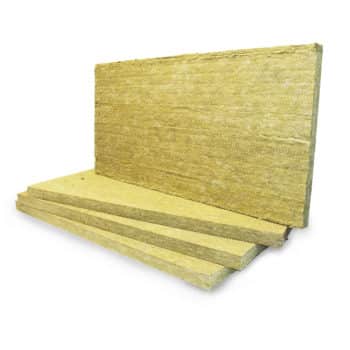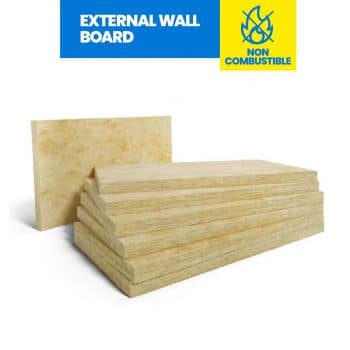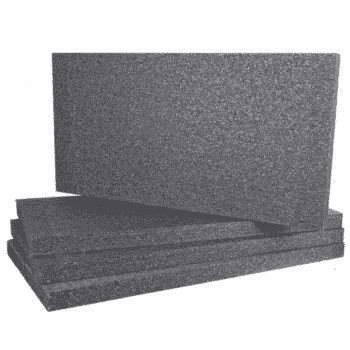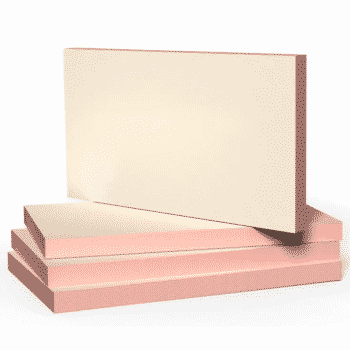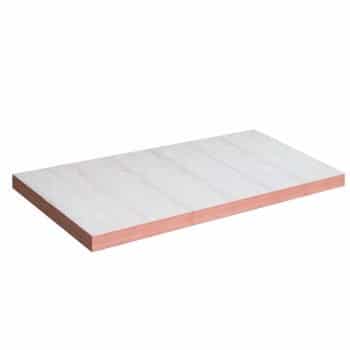What is the Best EWI Thickness?
When it comes to insulating your home, the thickness of the insulation material plays a crucial role in determining its effectiveness. Choosing the right insulation thickness can help you meet the U-value regulations for both retrofits and new builds while also providing long-term energy savings and thermal comfort. In this blog post, we’ll discuss U-value regulations, the ideal thickness for different insulation materials like EPS, mineral wool, and phenolic insulation, and the problems that may arise from not having thick enough insulation
UK building regulations
In the UK, building regulations play a crucial role in ensuring the energy efficiency, safety, and structural integrity of buildings. These regulations set standards for the design, construction, and alterations of buildings, including the installation of external wall insulation.
For external wall insulation, UK building regulations primarily focus on the following aspects:
- Thermal Performance (U-values) – Building regulations set specific U-value targets for new builds and retrofits to minimise heat loss and improve energy efficiency. These targets can vary depending on the country and region within the UK.
- Fire Safety – EWI materials must meet specific fire safety standards outlined in the building regulations. These regulations aim to minimise the risk of fire spread, especially in multi-story residential buildings. Materials like mineral wool provide excellent fire resistance properties.
- Condensation Control – Building regulations require that insulation installation should minimise the risk of condensation, both on the interior and exterior surfaces of the building. Properly installed insulation helps to maintain a consistent temperature and humidity level inside the building. In turn, reducing the risk of condensation and potential mould growth.
- Ventilation – Installing external wall insulation may affect the ventilation of a building. Building regulations emphasise the importance of maintaining adequate ventilation to ensure a healthy indoor environment.
- Structural Integrity – EWI can add weight to the building structure. As such, it is essential to ensure that the building can support the additional load. Building regulations require that structural assessments be carried out before installing external wall insulation to verify that the building can safely support the new insulation system.
- Planning Permission and Building Control Approval – You may require planning permission to install EWI, especially if the building is listed or located in a conservation area. Additionally, you will typically need building control approval to ensure the insulation work complies with the building regulations.
U-value regulations
U-value measures the rate of heat transfer through a building element, such as walls, windows, or roofs. The lower the U-value, the better the insulation properties. Therefore, less heat is lost through the building element. Both retrofits and new builds must adhere to U-value regulations to ensure energy efficiency and minimise heat loss.
| New builds | New elements in existing dwellings | Existing elements in existing dwellings | |
| Roofs | 0.11 W/m²K | 0.15 W/m²K | 0.16 W/m²K |
| Walls | 0.18 W/m²K | 0.18 W/m²K | 0.30 W/m²K |
| Floors | 0.13 W/m²K | 0.18 W/m²K | 0.25 W/m²K |
These values allow one to calculate the thickness of insulation you require. If you know the nature of the substrate, you can calculate the U-value of this and then determine the thickness required. The thickness will vary depending on which type of insulation you choose. EWI Store offers Mineral Wool, EPS, and Kingspan K5 which is a form of phenolic insulation.
-
Rockwool External Wall Dual Density Slab
Rated 5.00 out of 5From £26.24 Incl. VATFrom £21.87 Excl. VAT -
EPS Insulation (1 board = 0.72m²)
Rated 5.00 out of 5From £141.9 Incl. VATFrom £2.39 Incl. VATFrom £1.99 Excl. VAT -
Kingspan Kooltherm K5 External Wall Board (0.72m²)
Rated 4.67 out of 5From £11.99 Incl. VATFrom £9.99 Excl. VAT
The ‘best’ EWI thickness
It is difficult to qualify the best EWI thickness as it depends on the substrate you are working with! A brick wall will have a much higher U-value than ICF for example, therefore, a greater thickness if required. We do recommend a certain thickness for each insulation material.
EPS is a lightweight and cost-effective insulation material. To achieve a U-value that meets most building regulations, the thickness of EPS insulation should generally be between 90 and 150 mm (3.5 to 6 inches). The exact thickness required depends on the specific EPS product used and the existing wall construction. At EWI Store, we tend to say that 90mm will achieve a U-value of 0.3 W/m²K.
Mineral wool is a popular choice for external wall insulation due to its excellent fire resistance and soundproofing properties. The thickness required for mineral wool insulation to reach optimal U-value regulations typically ranges between 100 and 200 mm (4 to 8 inches). At EWI Store, we tend to say that 110mm will achieve a U-value of 0.3 W/m²K.
Phenolic insulation offers the highest thermal performance of the three materials mentioned here. It is a rigid foam insulation with low thermal conductivity, making it highly effective at reducing heat loss. To meet U-value regulations, phenolic insulation typically requires a thickness of 60 to 130 mm (2.75 to 5 inches). At EWI Store, we tend to say that 60mm will achieve a U-value of 0.3 W/m²K.
What if your insulation is not thick enough?
If the insulation installed in your building is not thick enough, it can result in a variety of issues that negatively impact energy efficiency, compliance with regulations, and overall comfort for occupants.
Firstly, insufficient insulation thickness can compromise the building’s thermal performance. Poor thermal performance leads to greater heat loss, which in turn results in increased energy consumption and higher heating bills. By ensuring that your insulation is of adequate thickness, you can enhance the building’s energy efficiency and save on energy costs.
Secondly, failing to meet U-value regulations due to inadequate insulation thickness can lead to non-compliance with building codes. Non-compliance may result in fines, potential legal complications, and even the need for costly remedial work to bring the building up to code. It is essential to consult local building regulations and guidelines to determine the appropriate insulation thickness required to meet U-value targets and avoid such issues.
Thirdly, a building with inadequate insulation may experience drafts, cold spots, and temperature fluctuations, which can significantly reduce indoor comfort for occupants. These issues can make living or working in the building less pleasant and may even have long-term implications on the occupants’ well-being. By choosing the right insulation thickness, you can ensure a more consistent and comfortable indoor environment.
Lastly, insufficient insulation can contribute to the formation of condensation on walls, which may lead to mould growth. Mould growth not only damages the building structure but also poses potential health risks for occupants, especially those with allergies, asthma, or compromised immune systems. By selecting the appropriate insulation thickness, you can minimise the risk of condensation and mould growth, ensuring a healthier living or working environment.
Facebook
Twitter
LinkedIn
Your cart
Trade Account Login

We use cookies on our website to give you the most relevant experience by remembering your preferences and repeat visits. By clicking “Accept All”, you consent to the use of ALL the cookies. However, you may visit "Cookie Settings" to provide personalised consent.
Manage consent
Privacy Overview
This website uses cookies to improve your experience while you navigate through the website. Out of these, the cookies that are categorized as necessary are stored on your browser as they are essential for the working of basic functionalities of the website. We also use third-party cookies that help us analyze and understand how you use this website. These cookies will be stored in your browser only with your consent. You also have the option to opt-out of these cookies. But opting out of some of these cookies may affect your browsing experience.
Necessary cookies are absolutely essential for the website to function properly. These cookies ensure basic functionalities and security features of the website, anonymously.
| Cookie | Duration | Description |
|---|---|---|
| __stripe_mid | 1 year | This cookie is set by Stripe payment gateway. This cookie is used to enable payment on the website without storing any patment information on a server. |
| __stripe_sid | 30 minutes | This cookie is set by Stripe payment gateway. This cookie is used to enable payment on the website without storing any patment information on a server. |
| _GRECAPTCHA | 5 months 27 days | This cookie is set by the Google recaptcha service to identify bots to protect the website against malicious spam attacks. |
| apbct_cookies_test | session | CleanTalk sets this cookie to prevent spam on comments and forms and act as a complete anti-spam solution and firewall for the site. |
| apbct_page_hits | session | CleanTalk sets this cookie to prevent spam on comments and forms and act as a complete anti-spam solution and firewall for the site. |
| apbct_prev_referer | session | Functional cookie placed by CleanTalk Spam Protect to store referring IDs and prevent unauthorized spam from being sent from the website. |
| apbct_site_landing_ts | session | CleanTalk sets this cookie to prevent spam on comments and forms and act as a complete anti-spam solution and firewall for the site. |
| apbct_site_referer | 3 days | This cookie is placed by CleanTalk Spam Protect to prevent spam and to store the referrer page address which led the user to the website. |
| apbct_timestamp | session | CleanTalk sets this cookie to prevent spam on comments and forms and act as a complete anti-spam solution and firewall for the site. |
| apbct_urls | 3 days | This cookie is placed by CleanTalk Spam Protect to prevent spam and to store the addresses (urls) visited on the website. |
| AWSALBCORS | 7 days | This cookie is managed by Amazon Web Services and is used for load balancing. |
| cookielawinfo-checkbox-advertisement | 1 year | Set by the GDPR Cookie Consent plugin, this cookie is used to record the user consent for the cookies in the "Advertisement" category . |
| cookielawinfo-checkbox-analytics | 11 months | This cookie is set by GDPR Cookie Consent plugin. The cookie is used to store the user consent for the cookies in the category "Analytics". |
| cookielawinfo-checkbox-functional | 11 months | The cookie is set by GDPR cookie consent to record the user consent for the cookies in the category "Functional". |
| cookielawinfo-checkbox-necessary | 11 months | This cookie is set by GDPR Cookie Consent plugin. The cookies is used to store the user consent for the cookies in the category "Necessary". |
| cookielawinfo-checkbox-others | 11 months | This cookie is set by GDPR Cookie Consent plugin. The cookie is used to store the user consent for the cookies in the category "Other. |
| cookielawinfo-checkbox-performance | 11 months | This cookie is set by GDPR Cookie Consent plugin. The cookie is used to store the user consent for the cookies in the category "Performance". |
| ct_checkjs | session | CleanTalk–Used to prevent spam on our comments and forms and acts as a complete anti-spam solution and firewall for this site. |
| ct_fkp_timestamp | session | CleanTalk sets this cookie to prevent spam on the site's comments/forms, and to act as a complete anti-spam solution and firewall for the site. |
| ct_pointer_data | session | CleanTalk sets this cookie to prevent spam on the site's comments/forms, and to act as a complete anti-spam solution and firewall for the site. |
| ct_ps_timestamp | session | CleanTalk sets this cookie to prevent spam on the site's comments/forms, and to act as a complete anti-spam solution and firewall for the site. |
| ct_sfw_pass_key | 1 month | CleanTalk sets this cookie to prevent spam on comments and forms and act as a complete anti-spam solution and firewall for the site. |
| ct_timezone | session | CleanTalk–Used to prevent spam on our comments and forms and acts as a complete anti-spam solution and firewall for this site. |
| elementor | never | This cookie is used by the website's WordPress theme. It allows the website owner to implement or change the website's content in real-time. |
| viewed_cookie_policy | 11 months | The cookie is set by the GDPR Cookie Consent plugin and is used to store whether or not user has consented to the use of cookies. It does not store any personal data. |
Functional cookies help to perform certain functionalities like sharing the content of the website on social media platforms, collect feedbacks, and other third-party features.
| Cookie | Duration | Description |
|---|---|---|
| __zlcmid | 1 year | This cookie is used by Zendesk live chat and is used to store the live chat ID. |
| bcookie | 2 years | LinkedIn sets this cookie from LinkedIn share buttons and ad tags to recognize browser ID. |
| bscookie | 2 years | LinkedIn sets this cookie to store performed actions on the website. |
| lang | session | LinkedIn sets this cookie to remember a user's language setting. |
| lidc | 1 day | LinkedIn sets the lidc cookie to facilitate data center selection. |
| UserMatchHistory | 1 month | LinkedIn sets this cookie for LinkedIn Ads ID syncing. |
Performance cookies are used to understand and analyze the key performance indexes of the website which helps in delivering a better user experience for the visitors.
| Cookie | Duration | Description |
|---|---|---|
| __utma | 2 years | This cookie is set by Google Analytics and is used to distinguish users and sessions. The cookie is created when the JavaScript library executes and there are no existing __utma cookies. The cookie is updated every time data is sent to Google Analytics. |
| __utmb | 30 minutes | Google Analytics sets this cookie, to determine new sessions/visits. __utmb cookie is created when the JavaScript library executes and there are no existing __utma cookies. It is updated every time data is sent to Google Analytics. |
| __utmc | session | The cookie is set by Google Analytics and is deleted when the user closes the browser. It is used to enable interoperability with urchin.js, which is an older version of Google Analytics and is used in conjunction with the __utmb cookie to determine new sessions/visits. |
| __utmt | 10 minutes | Google Analytics sets this cookie to inhibit request rate. |
| __utmv | 2 years | The __utmv cookie is set on the user's device, to enable Google Analytics to classify the visitor. |
| __utmz | 6 months | Google Analytics sets this cookie to store the traffic source or campaign by which the visitor reached the site. |
| sib_cuid | 6 months | Purechat uses this cookie to send data to purechat.com, to connect visitors to the reservation team and track visitors to stay on portal. |
| SRM_B | 1 year 24 days | Used by Microsoft Advertising as a unique ID for visitors. |
Analytical cookies are used to understand how visitors interact with the website. These cookies help provide information on metrics the number of visitors, bounce rate, traffic source, etc.
| Cookie | Duration | Description |
|---|---|---|
| _ga | 2 years | The _ga cookie, installed by Google Analytics, calculates visitor, session and campaign data and also keeps track of site usage for the site's analytics report. The cookie stores information anonymously and assigns a randomly generated number to recognize unique visitors. |
| _gat_gtag_UA_61069204_2 | 1 minute | Set by Google to distinguish users. |
| _gat_UA-61069204-2 | 1 minute | A variation of the _gat cookie set by Google Analytics and Google Tag Manager to allow website owners to track visitor behaviour and measure site performance. The pattern element in the name contains the unique identity number of the account or website it relates to. |
| _gcl_au | 3 months | Provided by Google Tag Manager to experiment advertisement efficiency of websites using their services. |
| _gid | 1 day | Installed by Google Analytics, _gid cookie stores information on how visitors use a website, while also creating an analytics report of the website's performance. Some of the data that are collected include the number of visitors, their source, and the pages they visit anonymously. |
| _uetsid | 1 day | This cookies are used to collect analytical information about how visitors use the website. This information is used to compile report and improve site. |
| CONSENT | 2 years | YouTube sets this cookie via embedded youtube-videos and registers anonymous statistical data. |
Advertisement cookies are used to provide visitors with relevant ads and marketing campaigns. These cookies track visitors across websites and collect information to provide customized ads.
| Cookie | Duration | Description |
|---|---|---|
| _fbp | 3 months | This cookie is set by Facebook to display advertisements when either on Facebook or on a digital platform powered by Facebook advertising, after visiting the website. |
| ANONCHK | 10 minutes | The ANONCHK cookie, set by Bing, is used to store a user's session ID and also verify the clicks from ads on the Bing search engine. The cookie helps in reporting and personalization as well. |
| fr | 3 months | Facebook sets this cookie to show relevant advertisements to users by tracking user behaviour across the web, on sites that have Facebook pixel or Facebook social plugin. |
| MUID | 1 year 24 days | Bing sets this cookie to recognize unique web browsers visiting Microsoft sites. This cookie is used for advertising, site analytics, and other operations. |
| NID | 6 months | NID cookie, set by Google, is used for advertising purposes; to limit the number of times the user sees an ad, to mute unwanted ads, and to measure the effectiveness of ads. |
| test_cookie | 15 minutes | The test_cookie is set by doubleclick.net and is used to determine if the user's browser supports cookies. |
| uuid | 6 months | MediaMath sets this cookie to avoid the same ads from being shown repeatedly and for relevant advertising. |
| VISITOR_INFO1_LIVE | 5 months 27 days | A cookie set by YouTube to measure bandwidth that determines whether the user gets the new or old player interface. |
| YSC | session | YSC cookie is set by Youtube and is used to track the views of embedded videos on Youtube pages. |
| yt-remote-connected-devices | never | YouTube sets this cookie to store the video preferences of the user using embedded YouTube video. |
| yt-remote-device-id | never | YouTube sets this cookie to store the video preferences of the user using embedded YouTube video. |
| yt.innertube::nextId | never | This cookie, set by YouTube, registers a unique ID to store data on what videos from YouTube the user has seen. |
| yt.innertube::requests | never | This cookie, set by YouTube, registers a unique ID to store data on what videos from YouTube the user has seen. |
Other uncategorized cookies are those that are being analyzed and have not been classified into a category as yet.
| Cookie | Duration | Description |
|---|---|---|
| _clck | 1 year | No description |
| _clsk | 1 day | No description |
| _uetvid | 1 year 24 days | No description available. |
| AnalyticsSyncHistory | 1 month | No description |
| apbct_pixel_url | session | No description |
| apbct_visible_fields_0 | session | No description |
| apbct_visible_fields_1 | session | No description |
| apbct_visible_fields_10 | session | No description |
| apbct_visible_fields_2 | session | No description |
| apbct_visible_fields_3 | session | No description |
| apbct_visible_fields_4 | session | No description |
| apbct_visible_fields_5 | session | No description |
| apbct_visible_fields_6 | session | No description |
| apbct_visible_fields_7 | session | No description |
| apbct_visible_fields_8 | session | No description |
| apbct_visible_fields_9 | session | No description |
| ct_checked_emails | session | No description |
| ct_has_scrolled | session | No description |
| ct_mouse_moved | session | No description |
| ct_screen_info | session | No description |
| ictf_master | never | No description available. |
| li_gc | 2 years | No description |
| m | 2 years | No description available. |
| SM | session | No description available. |
| testinfinitycookie | session | No description |
| woocommerce_show_tax | 7 days | No description available. |
| wp_woocommerce_session_c5ac76b408021294cb56bcc27eddf8a1 | 2 days | No description |


